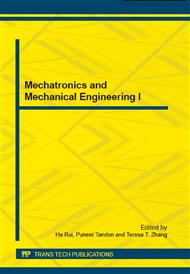p.254
p.263
p.268
p.274
p.279
p.284
p.288
p.293
p.298
A New Dielectric Elastomer Sensor Based on Cantilever Beam Structure with Constant Strength
Abstract:
Dielectric elastomer sensors are a new kind of capacitive sensors. They can be used to measure forces, pressures and deformations. The sensors have several advantages such as high elasticity and inexpensive fabrication compared with traditional sensors. In this paper, a new sensing device for measuring small concentrated force is proposed. The structure of the device is a cantilever beam with constant strength on which is fixed the dielectric membrane. The dielectric membrane is a capacitance sensor built with dielectric polymer coated with soft electrodes. When the cantilever beam is subjected to a concentrated force at its free end, the strain changed in the cantilever beam will induce the change in the capacitance of the membrane. According to the relation, the unknown concentrated force can be monitored by measuring the change in the capacitance. The testing results on the device show that the concentrated force at the free end of the cantilever beam is approximately proportional to the change in the capacitance. The prototype demonstrated the new device is capable of monitoring small concentrated force with prominent sensitivity.
Info:
Periodical:
Pages:
279-283
Citation:
Online since:
October 2014
Authors:
Price:
Сopyright:
© 2014 Trans Tech Publications Ltd. All Rights Reserved
Share:
Citation:


